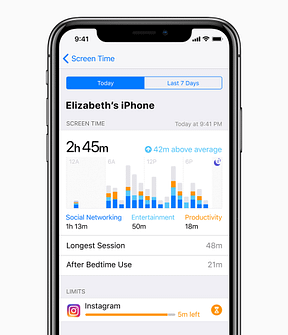
Dear Ms. Smartphone: Once a week (on Sundays) my iPhone sends a pop-up notification that reports how much screen time I have spent during the past week. I get a separate pop-up on my iPad. My question is not how to combine these two numbers, but rather, why is it that I ignore both of them? Kwame, San Francisco
Dear Kwame: You know, of course, you can turn this notification off, but it’s a good that you are thinking about its role. When Apple introduced this service back in 2018 on iOS 12, it was heralded as the long-awaited tool to moderate phone use and behaviors. Screen time measures the time spent on apps and websites, how often you pick up the phone and (ironically) what notifications are turned on.
The 2018 release was oriented towards parents: they might use it to manage their children’s content on the screen. Although they are adults today, the offspring of both Steve Jobs and Bill Gates were raised with limited access to technology. It’s noteworthy that children born after 2010 are truly the first all-phone, all-the-time generation.
Getting Accountable
In some ways, reporting the total time spent on the Internet is like stepping on a scale to get your weight. You get a measurement that you can hold yourself accountable to. And, as Apple intended, if you have young children or teens, that number could be a blunt tool: for example, 1 hour of homework equals 20 minutes of screentime. That said, there are many ways that clever children will find work-arounds, including downloading games to play off-line, resetting the phone’s clock, and even re-routing the family’s router. Nonetheless, boundaries and rules still count.
When I received your question, I asked adult friends why, like you, they don’t pay much attention to the weekly notification. The most common response was that a single number rolls up “good” uses of the phone, say for navigation or following an hour-long mindfulness app, plus the “bad” uses, like scrolling on Facebook, Twitter, and Instagram. The screen time feature also detail how much time was spent on each app, so technically you could do addition and subtraction.
Staying Accountable
That said, ‘time’ on device is still ‘time’ on device Our eyes, and physical presence have to rest. We also need to change scenery, and be in the fresh air. Significantly, we need to interact and spend time with other people, in- person. In 2013, five years before Apple introduced the Screentime measure, film-maker Tiffany Shlain, recommended that we take a Digital Sabbath, to manage our digital selves, restore our well being, and promote family togetherness. Watch the video to see her explain the value of the Digital Sabbath- a single day of the week in which we power off our electronic devices and empower ourselves.
Ironically, your own screen time notification arrives on Sunday, traditionally a day of rest. Making people more accountable and aware of their habits began with energy conservation. Electric utilities and water companies chose to report month to month usage data. People ignored that. Then, social psychologists discovered that the numerical reporting had more impact when it compared consumption in “your home” with the average energy consumption of neighboring users.
Perhaps there is a lesson here- a social element that smartphone users might respond to. I imagine a classroom teacher might use this to their advantage if they were teaching a course in digital literacy, and parents on Instagram could find new and clever ways to report on that site how their child “underachieves.”


Leave a Reply
You must be logged in to post a comment.